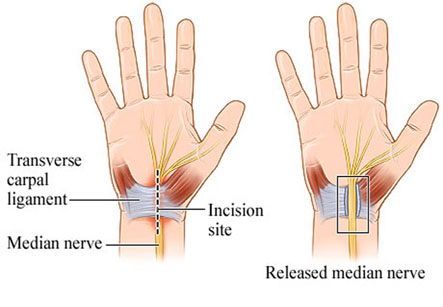Carpal Tunnel Surgery
Introduction
Carpal Tunnel is a small canal in the wrist that is made up of the wrist bones called carpal bones and the ligaments that connect bones of the hand with the muscles. The canal is the passage way for a major nerve called the median nerve and many tendons that connect the muscles of the forearm with those of the fingers. When there is a swelling in any of the contents of the canal or the synovial sheath covering them the space is further shortened and a painful condition known as the Carpal Tunnel Syndrome (CTS) results.
Procedure and Considerations
The main nerve affected is the medial nerve. It causes pain or tingling numbness on the palmer side of the thumb, index finger, middle finger and inside half of the ring finger. There may be shooting pain in the fingers, hand and forearm. Affection of this nerve also causes loss of power in the thumb. Surgical correction is one of the options in management of Carpal Tunnel Syndrome.
In open carpal tunnel release or correction, a long incision is made below the ring finger over the palm.
Iran ranks among the top 10 countries in orthopedics and Iranian surgeons perform high quality orthopedic surgeries at highly affordable prices

Common complications associated with surgery for correction include inadequate or failed correction, nerve, muscle, and tendon or ligament damage, bleeding, pain etc. Alternative to surgical correction of CTS are immobilization of the wrist with the help of a plaster cast or supportive and elastic bandage. Change of wrist posture and drugs to reduce swelling like anti-inflammatory drugs are other alternatives to surgery. Injections of steroids in the wrist is also undertaken to reduce the swelling and pain. Surgery however is the ultimate method of correction of CTS.
There are essentially two methods of CTS correction, open and endoscopic. Before the surgery your wrist will be X rayed to assess the type and extent of damage. After a mandatory general health checkup your surgeon may plan the surgery.
You will need to be empty stomach for 6 to 8 hours before the surgery. Usually a light dinner is recommended. Food or water in the stomach when under anesthesia can go into your lungs and may even cause death. Once inside the operation theatre an intravenous line will be made in one of the veins of the forearm that is not to be operated upon. You may be given medications to allay anxiety before the operation. Instruments to monitor your heart rate, rhythm (using EKG), blood pressure and oxygen saturation (to detect adequacy of breathing) will then be plugged in. Usually carpal tunnel surgery is performed under local or regional anesthesia. In some cases general anesthesia may also be needed. Under general anesthesia you will be unconscious during the surgery. When performed under regional anesthesia, injection of an anesthetic drug around one of the major nerves of the arm will make your arm numb while the operation is performed. A tourniquet or elastic bandage is tied to the upper arm in order to slow the flow of blood to the operative site. This minimizes bleeding during the operation. Your wrist, fore arm and hand will be cleaned with an antiseptic and draped in sterile surgical drapes.
In open carpal tunnel release or correction, a long incision is made below the ring finger over the palm. The incision extends from the middle of the palm up to just beyond the wrist. Once the skin and underlying sheath is incised retractors will be placed to hold the operative site open. With the help of blunt dissecting scissors the carpal tunnel will be then exposed.
The endoscope is a tubular structure with a camera at its tip that transmits images of the tunnel to a video monitor in the operation theatre.
In endoscopic carpal tunnel release one or 2 small incisions are made. One of the incisions can be a short horizontal one in the middle of the palm. Another small incision is also a short horizontal one at the level of the wrist. The surgical blades and the endoscope are inserted through each of these incisions. The endoscope is a tubular structure with a camera at its tip that transmits images of the tunnel to a video monitor in the operation theatre. Once the endoscope is used to visualize the tunnel the blades and dissecting assembly of instruments are used to release the pressure in the tunnel with or without cutting the tendons and ligaments or synovial sheath.
Once inside the Carpal Tunnel the pressure within the tunnel can be released with or without cutting the ligaments, tendons or synovial sheaths. Usually a ligament known as the Transverse Carpal Ligament is cut to allow the release of the pressure. The tourniquet is then removed and the surgical site is checked for bleeding points which can then be tied up. Skin can then be sutured back and the area bandaged. A plaster cast or splint may usually be applied after dressing to improve healing, prevent nerve or tendon damage.
Once the Carpal Tunnel surgery is over you will be taken to the recovery room. You will be given antibiotics and pain relieving medication. Depending on your general condition you can then be shifted to the hospital bed or discharged for home. Usually Carpal tunnel release surgery is done in day care and but you may need some one to drive you home after the surgery. Recovery is faster with the endoscopic technique compared to open surgery. Once the surgical scar starts healing you will be given exercises of your fingers and hand to prevent stiffness.